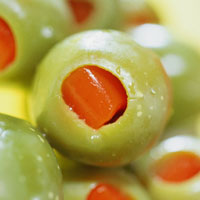Olives

Varieties
There are dozens of varieties of olives, and both their size and flavour vary. All fresh olives, almost never seen for sale, are quite bitter, and the final flavour of the fruit greatly depends on how ripe it is when picked and the processing it receives.
Underripe olives are always green, whereas ripe olives may be either green or black. Ripe olives are oilier than underripe ones. Olives that are tree ripened turn dark brown or black naturally, and while the majority of these olives are used for oil, the rest are brine- or salt-cured; they are usually packed in olive oil or a brine or vinegar solution.
Dry-cured olives have been packed in salt, which removes most of their moisture and creates intensely flavoured, dry, wrinkled fruit. These olives are sometimes rubbed with olive oil or packed with herbs.
Spanish olives are picked young, soaked in lye, and then fermented in brine for 6 to 12 months. When bottled, they’re packed in a weak brine and sold in a variety of forms, including pitted, unpitted, or stuffed with foods such as pimientos, almonds, onions, and jalapenos.
Greek olives (the most popular being the dark-skinned Kalamata variety) and Italian olives are not picked until they are fully tree-ripened, and so have a dark purple colour and are soft and juicy. They are then put down with rock salt in containers and left to stand for a few months before being packed in olive oil and marketed. Kalamata olives are also marinated in a wine-vinegar solution.
Copyright © 2024 TraceGains, Inc. All rights reserved.
Learn more about TraceGains, the company.
The information presented in the Food Guide is for informational purposes only and was created by a team of US–registered dietitians and food experts. Consult your doctor, practitioner, and/or pharmacist for any health problem and before using any supplements, making dietary changes, or before making any changes in prescribed medications. Information expires December 2024.



 We are proud to announce that
We are proud to announce that  As the market evolves, customers increasingly request a wider variety of omega-3 options for their lipid...
As the market evolves, customers increasingly request a wider variety of omega-3 options for their lipid...  Maintaining healthy glucose levels is crucial for preventing metabolic conditions like diabetes,...
Maintaining healthy glucose levels is crucial for preventing metabolic conditions like diabetes,...  Looking at formulating a new vitamin blend? Discover
Looking at formulating a new vitamin blend? Discover 







































